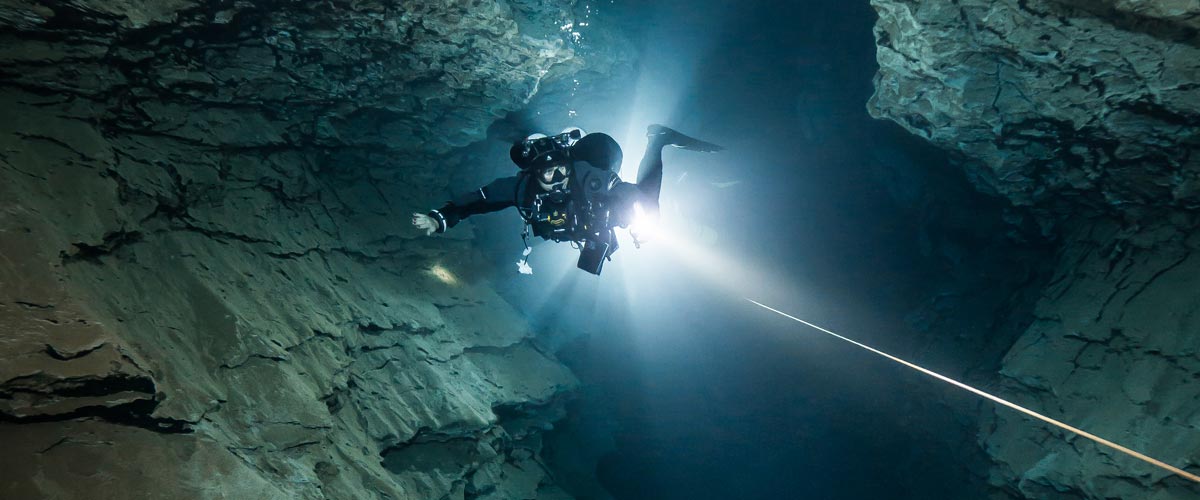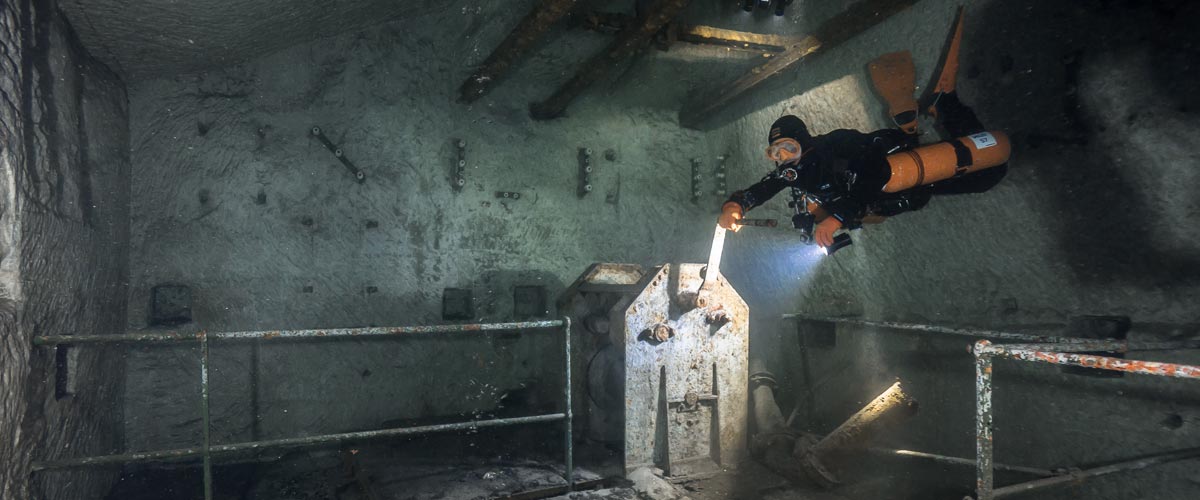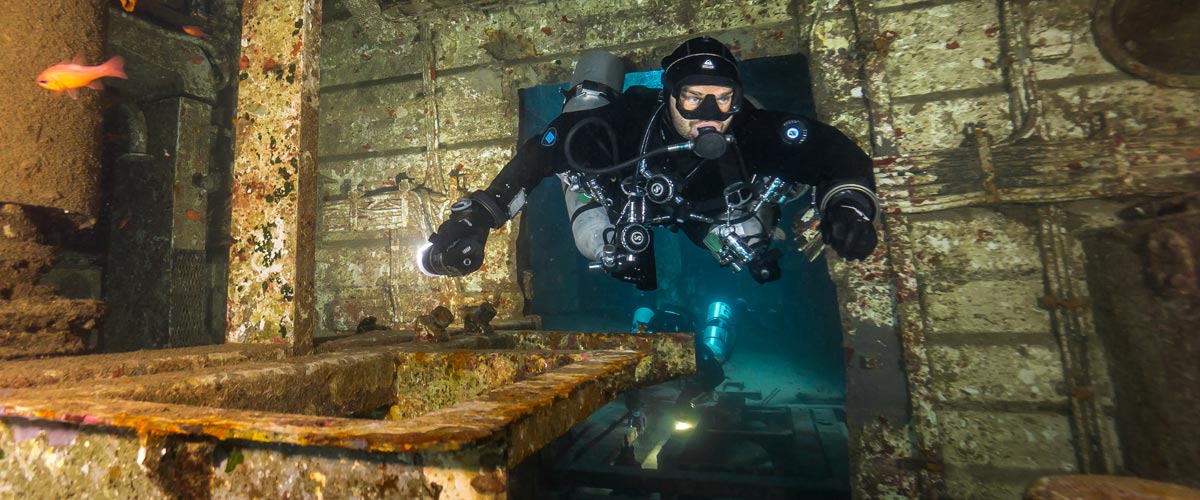Dive Training Blogs
Scuba Professional: Column No. 4
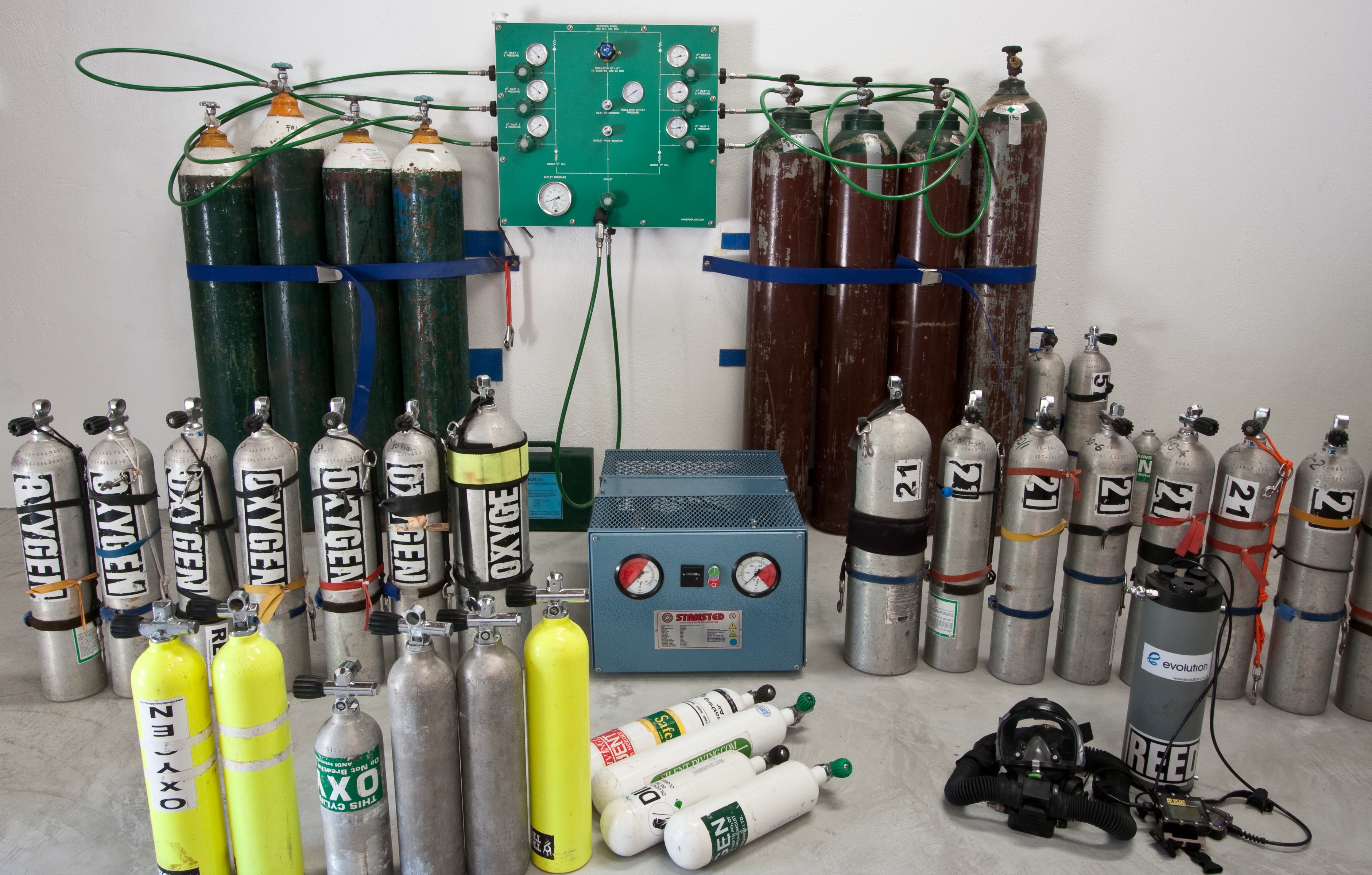
“How Did That Get in There?”
Simon Pridmore looks at the common practice of filling scuba cylinders while they are standing in water and asks “Why?”
Anna is a new diver.
“I was on my ninth dive ever, about five minutes in and at a depth of around 12m when I realized that my air was not coming out smoothly. I couldn’t think why this should be. I had checked my pressure gauge on descent and it had shown 190 Bar. I switched to my octopus, but there was no difference. Soon the air became very thin.
I tried to stay calm. Everyone else was going deeper and swimming away from me. Then the air stopped completely. I held my breath. I looked around and there was my husband. He gave me his regulator and took me to the surface with him.”
Anna’s husband, an experienced instructor, takes up the story.
“I had checked my wife’s set up as usual before the dive. The pressure gauge was showing 190 Bar on the surface. A few minutes into the dive, I saw her hovering away from the reef in mid water, sensed something was wrong and swam towards her. She gave me a wide-eyed look and pointed at her regulator. I glanced at her gauge and saw it was at zero so I gave her my octopus and we went up together. “
“I was puzzled as to how a full tank could become empty so quickly. We were definitely no more than 10 minutes into the dive and there had been no O-ring blow out. After the dive, I removed the regulator and opened the tank valve. Nothing came out. Some instinct made me turn the tank upside down and, to everyone’s surprise, water started flowing out of the valve. It was fresh water!”
An Incredible Story?
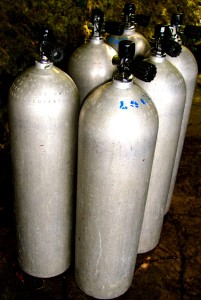 It seems incredible that a scuba cylinder should be so full of water that a diver would only get a few minutes of air. Some might interpret the story simply as a misunderstanding on the part of a new diver with a supportive husband.
It seems incredible that a scuba cylinder should be so full of water that a diver would only get a few minutes of air. Some might interpret the story simply as a misunderstanding on the part of a new diver with a supportive husband.
However, when I heard the story, it brought to mind something that I came across when I had a dive store in Guam. We used to conduct annual visual inspections on cylinders owned by local residents and were surprised to often find a few centimetres of water in the bottom of cylinders. This was always fresh water, not seawater. We made some enquiries and found that this is fairly common and comes from the almost universal practice in dive stores around the world of filling scuba cylinders while they are standing in a trough of water.
The fill whips, hoses that are clamped onto the valves of scuba cylinders to fill them, sometimes drop into the water trough between cylinder fills. When the wet clamps are then attached to the valve of the next cylinder and the airflow is turned on, the pressure of the air in the fill whip is higher than the pressure of the air in the cylinder and water droplets are driven into the cylinder.
Fill the cylinder several times and the amount of water inside accumulates until you have a little pool in the bottom. The moisture inside causes corrosion to build inside the cylinder too.
Bear in mind that I was in Guam, part of the USA, where a stringent system of cylinder inspections applies and is enforced by dive operators. The maximum length of time between inspections is 12 months so that means the water inside the cylinders had accumulated in less than a year.
In many places in the world where people dive, including the island nation where Anna’s dive took place, there are no regulations governing cylinder inspection, so it is possible that a cylinder could go for many years without anyone examining the interior.
Therefore, Anna’s story is not as far-fetched as it might initially seem. With her cylinder containing a large amount of fresh water, the volume of air in the cylinder was quite small so once she started her dive she used it up very quickly. The reading on her pressure gauge must have been dropping fast during those first few minutes of her dive but she did not notice.
Why Do They Do It?
Dive centres fill cylinders while they are standing in water for three reasons:
- To keep them cooler during the filling process, which generates heat, so they can fill them faster and so the air pressure inside does not drop so much when they cool down afterwards and they don’t have spend time hooking them up again to top them off.
- As a convenient way to wash salt off them post dive, and
- To protect the filler from harm if the cylinder explodes during filling.
All three of these reasons are the product of fuzzy thinking.
- Filling the cylinder in water has very little impact on the cylinder temperature, partly because the heat from the filling process is transferred to the water, which then gets warmer. Fast filling still causes the cylinder to get hot, despite the water bath, so it still has to be filled to 20 Bar or so beyond its rated pressure. This makes sure that the pressure is 200 Bar or more when the cylinder is cool. Otherwise divers will complain. The only effective way to stop a cylinder getting too hot while it is being filled is to fill it slowly and from a bank of large cool high-pressure air cylinders rather than directly from the compressor.
- Using the fill bucket to wash the salt off the cylinder is ineffective as all that happens is that the water the cylinder stands in becomes a little salty. A quick fresh water blast with a hose before the cylinder is taken into the compressor room does a much better job.
- Aluminium cylinders have exploded during the filling process in the past and when this has happened the consequences have often been fatal. However, an exploding cylinder is a bomb and no concrete trough is going to protect the person filling it. Instead it will just contribute more shrapnel to the explosion.
Having said this, those aluminium cylinders that exploded were made from a 6351 alloy containing lead and it was the presence of lead in the alloy that created the problems that caused them to explode. Since 1988, no aluminium scuba cylinders have been made using this alloy or with any alloy containing lead. The vast majority of scuba cylinders in service today worldwide, including all cylinders made by Luxfer and Catalina, the top two manufacturers, are made from an alloy called 6061.
Although, during annual inspections, cracks have occasionally been found in 6061 cylinders, none has exploded: ever! And there are millions out there.
No Need for a Bath?
It is worth noting here that not all dive centres that fill cylinders in water are ignorant and negligent. There are many dive centres that fully recognise the potential issues and take elaborate precautions to make sure their whips and cylinder valves stay completely dry during the filling process so that water does not get into their cylinders.
But if,
- The likelihood that a scuba cylinder will explode during filling is so remote,
- A water trough will not protect a filler if it does happen,
- The water trough is not an effective way of removing salt or reducing the cylinder’s temperature sufficiently and,
- The practice of wet-filling can allow water to enter a cylinder and lead to an incident such as Anna’s,
why do it at all?
Ironic, isn’t it, that, from day one, divers are constantly told always to leave some air in their cylinder at the end of a dive so that no water can get in! And yet ……
Read more from Simon in his latest release Scuba Professional – Insights into Sport Diver Training & Operations and his bestselling book Scuba Confidential – An Insider’s Guide to Becoming a Better Diver, both available from Amazon in paperback and e-book versions.
Blogs
Intro to Tech: What is it about?
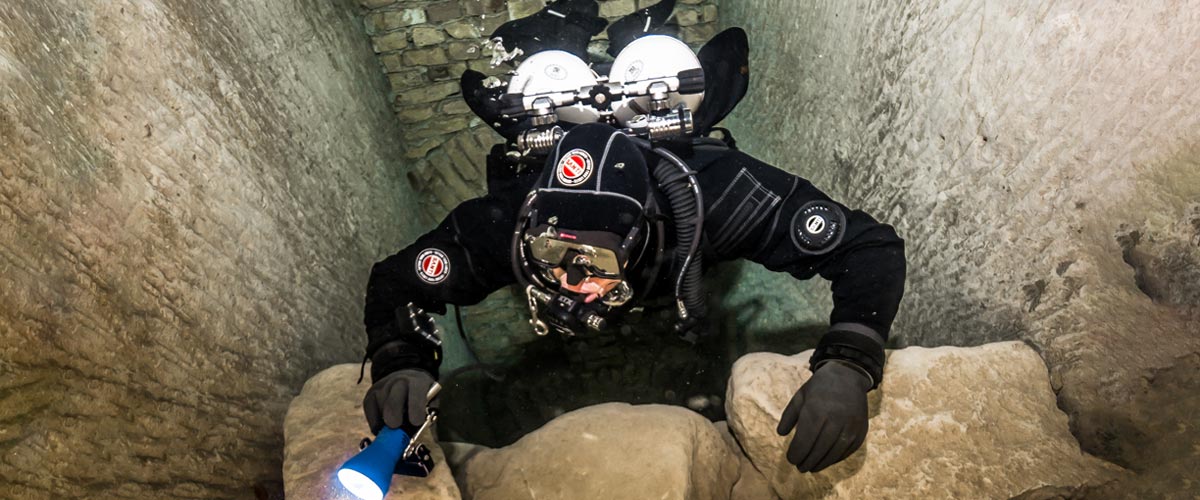
Article by José Pablo Mir
Pictures by Cezary Abramowski
The world of technical diving is exciting. It opens the door to new sites, depths, and bottom times. More importantly, it opens our minds to a new way of planning, facing, and experiencing dives, even those not purely technical.
Becoming a technical diver is a process, and like in other aspects of life, we should find the proper entry point that suits us best based on our knowledge and experience. The Introduction to Technical Diving course from TDI -the world’s largest and most recognized technical diving teaching organization- is the best option for divers who have yet to gain experience in the fundamental aspects of this new practice. The course’s content and its embrace of new techniques and technologies make it possible to acquire a solid foundation to learn and gain experience in this practice properly.
Becoming a technical diver is not something that happens overnight, whether deciding to become one or receiving a certification card stating we are now technical divers. It is a slow process extending farther away than any introductory course. It requires effort and dedication. But it will bring us satisfaction from day one -or two.
It is a matter of mentality
First, we must understand and accept that technical diving, involving greater depths, longer bottom times, exotic gases, virtual or real ceilings, and more, comes with higher levels of risk than the sport diving we have been practicing until now.
Although this discussion usually starts with a warning about risks, as I’ve done in the previous sentence, our practice is not a game of chance.
Technical diving is a rational activity that requires maturity and good judgment, and we will put everything into ensuring that each dive is a successful one -meaning we return from it safe and sound. With this understanding, we will strive to establish a mental attitude more aligned with our practice and its realities.
This new “technical diver” mindset we will develop will lead us to be more cautious in our executions, more analytical in our plans, more rational in our strategies, and more detailed in our procedures.
Experience will keep teaching us to know ourselves better, to keep our anxiety and other emotions under control, and to manage our impulses. Over time, our senses will sharpen, and we will be more attentive to the particulars of the situation we find ourselves in.
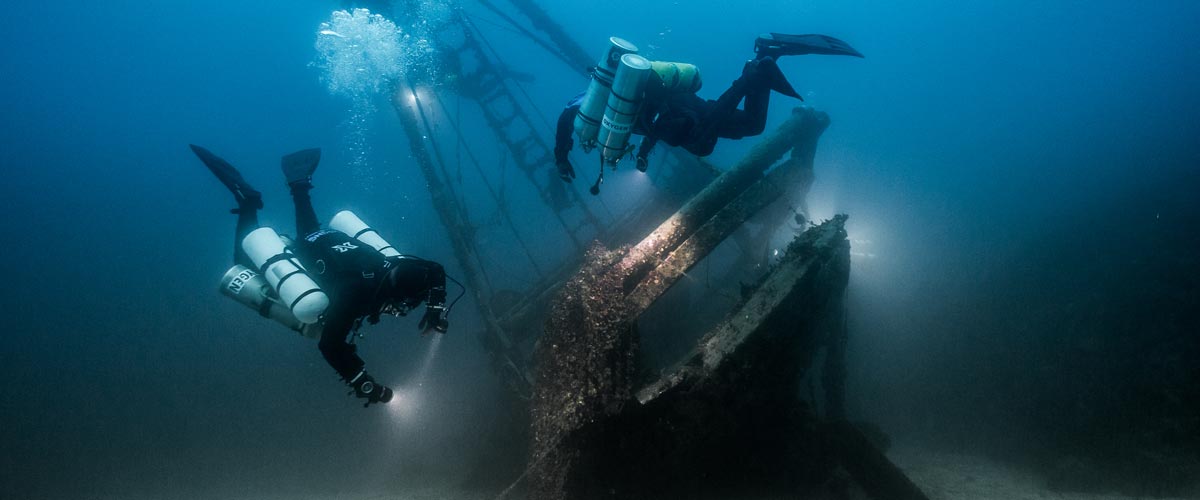
Strategies and procedures
Our strategies, those broad guiding lines tracing the path to follow, from how to approach planning to where, with what, and how we are willing to get there, will be more specific and more practical. Not because they magically become so, but because we will consciously and deliberately frame them that way.
We will establish clear, concise, and realistic procedures. Not only for the undesirable situations that may present themselves but also for those that are part of our dive objectives.
Even though, as technical divers, we often use equipment different from what we were previously accustomed to, it is essential to note that the gear does not make the diver. In a way, we could consider such equipment as the necessary tools to implement what our goal seeks to achieve, according to our strategies and procedures.
Technique plays an important role
We must put our greatest effort into learning and perfecting the different techniques we will be acquiring. Buoyancy, trim, propulsion, cylinder handling, deploying DSMBs and lift bags, valve drills, and more are essential skills we must begin to master to progress in our art. What we cannot do, when we need to do it, can harm us.
Our techniques must be effective and achieve the purpose for which they were devised. But they must also be efficient and require the least resources possible, including the time they take and the effort they demand. Effectiveness and efficiency will prevail over beauty and other considerations that may come to mind, although none of them should be mutually exclusive. A technique executed efficiently and effectively tends to have an inherent beauty.
Refining techniques is a lifelong mission. Some of them will be easy to master from the go; others, on the other hand, will be our life mission and will require many repetitions just to resemble the idea we have in mind of how they should be executed.
We must consider the environment
Our learning, the needs and musts of the practice we engage in, the experience we gradually gain, our strategies and procedures, and even our equipment and tools change with the environment.
Diving in the ocean, everything about us must be suitable for ocean dives. Conditions there rarely emulate those found in a pool, lake, or river. Variable winds and currents, greater depths, visibility conditions, other divers with uncertain skills around us, marine life, maritime traffic, distance from the coast, and many other factors add complexity and uncertainty.
It is never necessary to master the pool on the first day, but planning and aspiring to gradually cope with the ocean’s conditions is essential.
The cost of good training
We are aware that our resources are often scarce in relation to the possibilities of use we could give them if they were not. To a greater or lesser extent, we are part of the economic reality in which we are embedded.
Fortunately, the cost of good technical diver training is not an entry barrier. Comparing training and equipment costs, we see that the former are generally lower. Yes, lower cost for personalized service, essential to our future
performance and safety, than for a series of mass-produced products that are mere, albeit necessary, tools for an end.
The value of good training
The value of the training we received encompasses a range of characteristics, from emotional and methodological to technical and technological. TDI and its Introduction to Technical Diving course offer a deep and modern approach, with a teaching strategy that aims to create thinking divers, not merely obedient ones.
As technical divers, our knowledge is our primary tool. In this type of activity, what we don’t know can harm us.
Is this course optional?
Unfortunately, the fact that this Introduction to Technical Diving course is not a prerequisite for any subsequent training is an invitation to consider it optional. And we all know what usually happens to “optional” under budget constraints.
However, this course should be seen as optional only by those divers who are somehow familiar with the use of technical equipment, who have a mindset more in line with the requirements of this type of diving, who plan and execute the dives the proper “technical” way, who know their gas consumption rate, who are not intimidated by non-decompression tables, who feel comfortable using their dive computers, and know the techniques and have at least an acceptable level of buoyancy, positioning, and propulsion. Those can go straight to a more advanced training course, such as TDI’s Advanced Nitrox.
We must ask ourselves whether or not we are in that group.
Remember our goal: to have fun
Recreational diving is our passion. Jumping into the water carrying heavy equipment and having properly dotted our I’s and crossed our T’s have only one ultimate goal: fun. This is the activity we have chosen as a hobby. We must enjoy it; it must give us pleasure and make us vibrate.
Having a good time is not optional!
Blogs
Four opportunities to go pro in 2024 with Dive Friends Bonaire
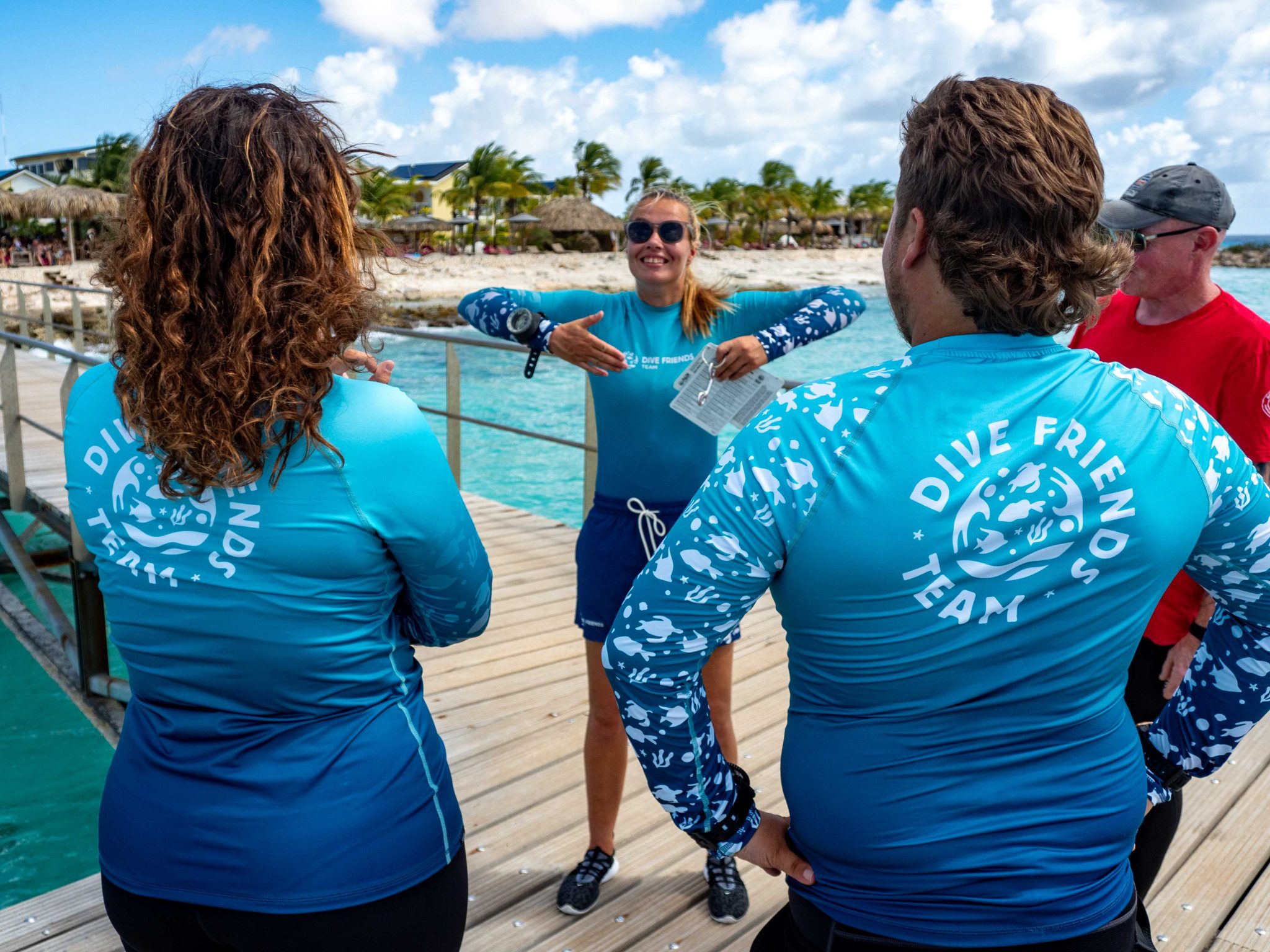
Dive Friends teaches the Instructor Development Course (IDC) several times a year to students who are eager to share their passion for diving with the world.
Dive Friends is known for the personal approach throughout the course. Their in-house course director will lead the students through every essential step, mentoring them to achieve their fullest potential as a dive instructor.
Applications for the following IDC start dates are now open:
- 12 April
- 5 July,
- 20 September
- 29 November
Partnership with Casita Palma
If the student opts for the IDC-Deluxe or IDC-Supreme package, their accommodation will be arranged for them at Casita Palma. This small and quiet resort is within walking distance from Dive Friends Bonaire’s main dive shop location and has everything you need to relax after an intense day of IDC training. Breakfast is included, so the student will always be fuelled and ready for their day.
Contact Dive Friends Bonaire’s Course Director Eddy for more information: coursedirector@divefriendsbonaire.com.
-

 News3 months ago
News3 months agoHone your underwater photography skills with Alphamarine Photography at Red Sea Diving Safari in March
-

 News3 months ago
News3 months agoCapturing Critters in Lembeh Underwater Photography Workshop 2024: Event Roundup
-

 Marine Life & Conservation Blogs3 months ago
Marine Life & Conservation Blogs3 months agoCreature Feature: Swell Sharks
-

 Blogs2 months ago
Blogs2 months agoMurex Resorts: Passport to Paradise!
-

 Blogs2 months ago
Blogs2 months agoDiver Discovering Whale Skeletons Beneath Ice Judged World’s Best Underwater Photograph
-

 Gear Reviews2 weeks ago
Gear Reviews2 weeks agoGEAR REVIEW – Revolutionising Diving Comfort: The Sharkskin T2 Chillproof Suit
-

 Marine Life & Conservation2 months ago
Marine Life & Conservation2 months agoSave the Manatee Club launches brand new webcams at Silver Springs State Park, Florida
-

 Gear Reviews3 months ago
Gear Reviews3 months agoGear Review: Oceanic+ Dive Housing for iPhone















